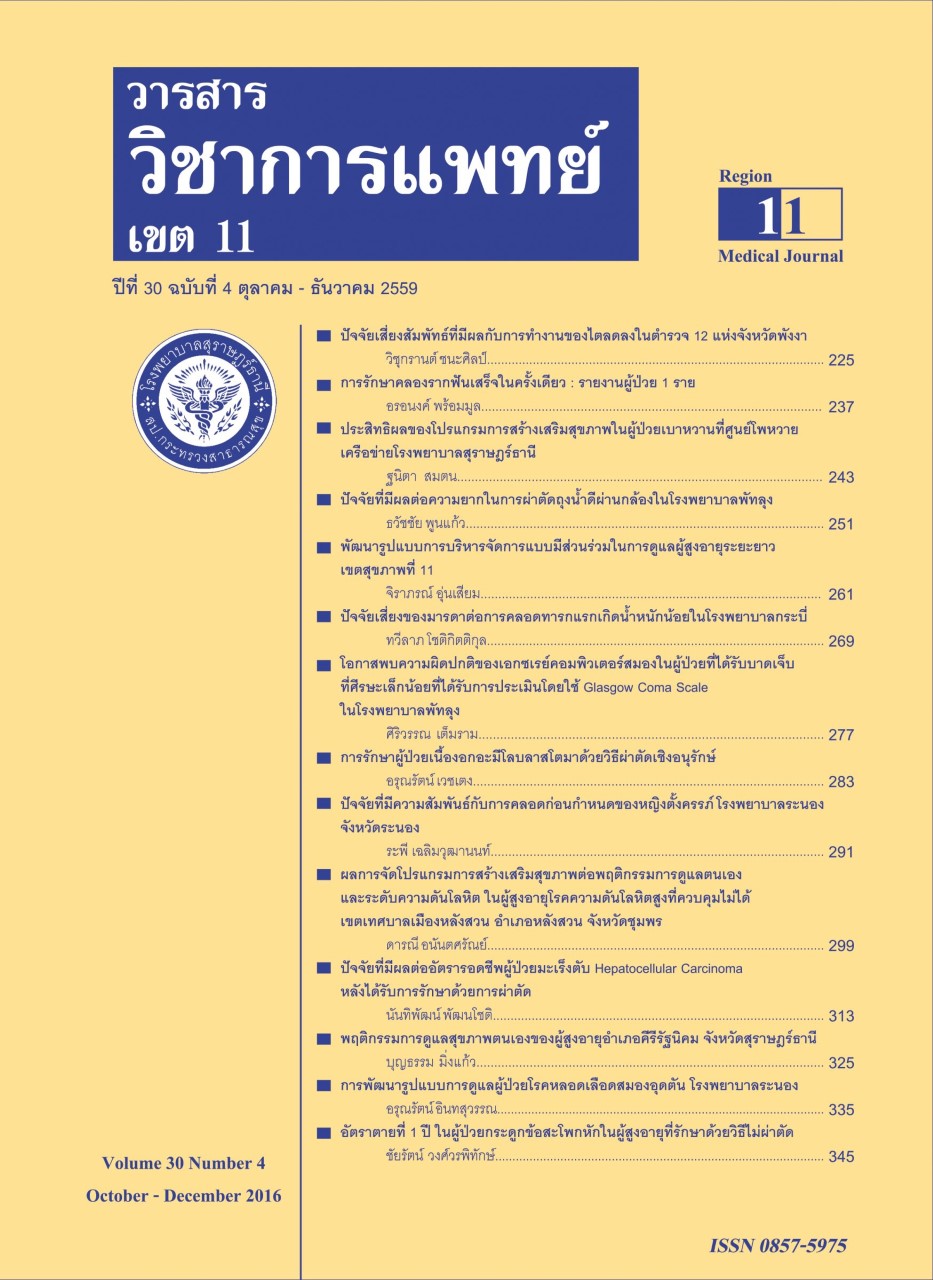Risk factors for kidney damage in policeman 12 station,Phang-nga.
Keywords:
kidney damageAbstract
Chronic kidney disease (CKD) is a major public health problem in Thailand. But no data of the CKD prevalence has been reported in Phang-nga province. A retrospective descriptive study
of 585 policeman who working in 12 station Phang-nga district since January 18,2016 was performed to evaluate risk factors for kidney damagein these policemen. Statistical used for analyzing data were
mean ,standard deviation, Student t-test ,Chi-square ,Odds ratio (OR) and 95% Confidence Interval .The results were Total of 585 policeman,diabetic type II 9.7%,high uric acid 36.9%,high systolic blood pressure 30.3%, high diastolic blood pressure 43.3%,high cholesterol 71.6%,high LDL 84.6%,high triglyceride 46.5%,low HDL 46.5%,eGFR 60-89 mL/min/1.73m3 56.8% ,eGFR<60 mL/min/1.73m3
3.8%,eGFR 30-59 mL/min/1.73m3 3.6%. Age 50 years, BMI>25,Urine protein 2+-4+, glucose<100 mg%,high uric acid were the risk of reduce estimated glomerular filtration rate(eGFR<90 mL/
min/1.73m3) but high blood pressure (10 hypertension) and Dyslipidemia not relative to reduce estimated glomerular filtration rate(eGFR<90 mL/min/1.73m3).
References
5/ncds/2/173/176-กลุ่มโรค+NCDs.html
2. Coresh J, Selvin E, Stevens LA, Manzi J, Kusek JW, Eggers P, et al. Prevalence of chronic kidney disease in the United States. Jama 2007; 298(17): 2038-47.
3. Collins, A J. The hemoglobin link to adverse outcomes.Advanced Studies in Medicine,2003;3(3):14 –17.
4. สถิติสาธารณสุข,(2558).
5. Violanti JM, Burchfiel CM, Miller DB, Andrew ME,Dorn J, Wactawski-Wende J, et al. The Buffalo Cardio-Metabolic Occupational Police Stress (BCOPS) Pilot Study: Methods and Participant Characteristics.AnnuEpidemiol 2006;16:148-56.
6. Ramey SL. Cardiovascular disease risk factors and the perception of general health among male law enforcement officers: Encouraging behavioral change. AAOHN J.2003;51(5):219-26.
7. วิชัย เอกพลากร.สถานการณ์โรคเบาหวาน.2549.[ค้นเมื่อ 29 พฤศจิกายน 2559 จาก http://www.hiso.or.th]
8. กมลทิพย์ วิจิตรุนทรกุล.aunual report 2015 bureau of non communicable disease.[ค้นเมื่อ 29 พฤศจิกายน 2559 จาก http://www.thaincd.com]
9. วิฑูรย์ โล่สุนทร.ความชุกของกรดยูริกในเลือดสูง.และความสัมพันธ์กับกลุ่มอาการเมตาโบลิคในผู้ใหญ่ไทยที่มารับการตรวจสุขภาพประจำปี.ภาควิชาเวชศาสตร์ ป้องกันและสังคม จุฬาลงกรณ์มหาวิทยาลัย;กรุงเทพ: 2543.
10. Cai, Z., Xu, X., Wu, X., Zhou, C., & Li,D.Hyperuricemia and the metabolic syndrome in Hangzhou. Asia Pac J ClinNutr 2009, 18(1), 81-87.
11. Chen, L.K., Lin, M.H., Lai, H.Y., Hwang, S.J.,&Chiou, S.T.Uric acid: A surrogate of insulin resistance in older women. Maturitas2008 , 59, 55-61.
12. Lohsoonthorn, V., Dhanamun, B., & Williams, M.A. Prevalence of Hyperuricemia and its Relationship
with Metabolic Syndrome in Thai Adults Receiving Annual Health Exams. Archives of Medical Research2006,
37, 883–889.
13. สุเมธ เถาหมอ. (2550). โรคเก๊าท์และการดูแลอาหาร ของผู้ที่เป็นโรคเก๊าท์.ค้นเมื่อ 10 พฤศจิกายน 2554,จากhttp://www.vibhavadi.com/web/health_detail. php?id=109
14. สุชาติ เจนเกรียงไกร (2551) ท?ำการศึกษาความชุกของโรคไตเรื้อรังระยะต่างๆในผู้ที่มารับบริการตรวจสุขภาพ
ที่โรงพยาบาลมหาราชนครราชสีมา.เวชสารโรงพยาบาลมหาราชนครราชสีมา. 2551;32(1) :158-165.
15.Perkovic V, Cass A, Patel AA, Suriyawong paisal P, Barzi F, Chadban S, et al. High prevalence of
chronic kidney disease inThailand. Kidney Int 2008; 73: 473-9.
16. Chittinandana A, Chailimpamontree W, Chaloeiphap P. Prevalence of chronic kidney disease in
Thai adult population. J Med Assoc Thai 2006; 89 Suppl 2: S112-20.
17. ชุติมา กาญจนวงศ์.(2551).Diabetic nephropathy in type 2 diabetic patients at Lampang Hospital.
ล?ำปางเวชสาร 2551,1:20-29
18. Coresh J, Astor BC, Greene T, Eknoyan G, LeveyAS.Prevalence of chronic kidney disease and
decreased kidneyfunction in the adult US population: Third National Health and Nutrition Examination Survey. Am J Kidney Dis 2003; 41:1-12.
19. Ong-ajyooth L, Vareesangthip K, Khonputsa P,Aekplakorn W. Prevalence of chronic kidney disease in Thai adults : a national health survey.BMC Nephrol2009 ; 10 : 35.
20. Singh AK, Farag YMK, Mittal BV, Subramanian KK,Reddy SRK, Acharya WN, et al. Epidemiology
and risk factors of chronic kidney disease in India – results from the SEEK (Screening and Early Evaluation of Kidney Disease) study. BMC Nephrology 2013 ; 14 : 114-125.
21. Sabanayagam C, Lim SC, Wong TY, Lee J, Shankar A, Tai S. Ethnic disparities in prevalence and
impact of risk factors of chronic kidney disease.Nephrol Dial Transplant 2010 ; 25 : 2564-70.
22. Kim S, Lim CS, Han DC, Kim GS, Chin HJ, Kim SJ, et al. The prevalence of chronic kidney disease
(CKD) and the associated factors to CKD in urban Korea : a population-based cross-sectional epidemiologic study. J Korean Med Sci2009 ; 24 (Suppl) : S11-21.
23. ฉัตรประอร งามอุโฆษ และคณะ(2007: S37-42) .ปัจจัยที่มีความสัมพันธ์กับภาวะแทรกซ้อนทางไต.
24. ศูนย์โรคไต โรงพยาบาลบ?ำรุงราษฎร์.(2559).การดูแล สุขภาพโรคไตเรื้อรัง.URL :http://www.Bumrungrad.
com/th/[สืบค้นเมื่อวันที่ 4 มิถุนายน 2559]
25. Ravid M, Brosh D, Levi Z, Bar-Dayan Y, Ravid D,Rachmani R.(1998).Use of enalapril to attenuate
declinein renal function in normotensive, normoalbuminuric patients with type 2 diabetes mellitus:
a randomized, controlled trial. Ann Intern Med 1998; 128: 982-88
26. อตินุช ดวงแก้ว มาศ ไม้ประเสริฐ และพัฒนา เต็งอำนวย.(2553). ความชุกของภาวะกรดยูริกใน เลือดสูงและความสัมพันธ์ต่อระดับไขมันในเลือด ผิดปกติ โรคเบาหวานชนิดที่ 2 และความดันโลหิตสูง ในประชากรที่รับการตรวจร่างกายประจำปีที่
โรงพยาบาลพญาไท 2 กรุงเทพฯ.นิสิตปริญญาโท สาขาวิชาเวชศาสตร์ชะลอวัยและฟื้นฟูสุขภาพ มหาวิทยาลัยแม่ฟ้าหลวง.






